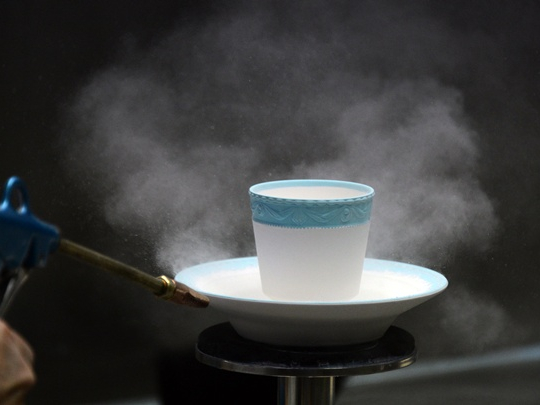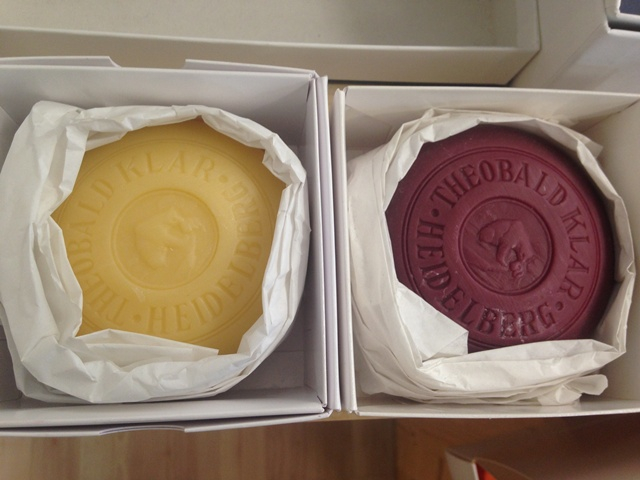
To aficionados of German luxury products, Riesling and Pinot Noir, or Spätburgunder as it’s called here, might conjure up images of tall green bottles, but at the 1,000-year-old university town of Heidelberg, they’re simply two kinds of handmade soap. Flavours, unfortunately, that Klar Seifen has for the moment nearly run out of at its factory store, because the product is a runaway success. Almost everyone in our group of visitors wants one.
For 175 years, five generations of Klars have been based in this southwestern town, from where they now retail soap, perfume and cosmetics around Germany — and to fans elsewhere. While the production process and many of the machines may date back over a century, grape-flavoured soaps are among a series of innovations launched by Niels Klar, who took over the family business in 2006. He launched new flavours (lavender and grape seed), emphasised the animal-free production process — Klar soaps use only organic vegetable oils — and perhaps more importantly, rolled out a retail line bearing his family name. “I wanted to create our own brand, with our own products but inspired by our company’s — and our family’s — history,” he says, showing GN Focus around his factory and regaling us with tales of growing up around soap.
Family values underpin Germany’s Mittelstand, or small to medium-sized enterprises (SMEs), which make up 99.6 per cent of the country’s companies and are responsible for 62 per cent of all jobs, according to Germany Trade & Invest (GTAI), which promotes inward investment. They contributed €2.1 trillion (about Dh8.5 trillion) to the country’s GDP, about 56 per cent, says Michael Leibrandt, an official at the foreign trade and investment board at the Ministry of Economic Affairs and Energy.
None of that happens without support, of course, and the government offers cash and labour incentives, and research and development grants. Companies looking for international markets, for example, will find help at GTAI, including a subsidy of foreign visits. “Generally, we think there shouldn’t be a free lunch, so if you need specialised help, we will ask for some money,” says Leibrandt.
On trade visits, companies may need to pay as much as 50 per cent of the total cost, but for some sectors a ceiling of €500 keeps it affordable. Leibrandt and Klar spoke to GN Focus on the sidelines of Handmade in Germany, an annual manufacturing exhibition created to spotlight handmade products and the “manufactories” that create them. Among them were international brands like pencil maker Graf von Faber-Castell, camera manufacturer Leica, the trendy spectacles label Mykita and the leather goods start-up Munk Bogballe. About 30 companies are part of the government-supported event, in the hope that the exposure will yield business benefits.
About 1,300 SMEs are considered among the country’s hidden champions, a term used to describe little-known brands that are often among international leaders in their respective segments. If the relatively small country was the world’s top exporter for several years (it has since slipped to third place behind the US, and market leader China), it became so on the back of its SMEs, argued Hermann Simon, who coined the term in a 1996 book. If the country powered through the financial crisis of 2008, it did so partly because of the strength of its family-owned SMEs. In the years 2008 to 2010, more than half of all Mittelstand firms launched a product or process innovation, compared to the EU average of 34 per cent, GTAI data shows.
“These companies are the basis of German industry,” says Michael T. Schroeder, who set up the initiative five years ago to promote handcrafted products that are created almost entirely within the country and support the local economy in their far-flung home regions. While international consumers know the Made in Germany brand, Schroeder says this recognition is often limited to large companies such as BMW and Mercedes-Benz.
“Manufacturing has been a German hallmark for centuries and it is these companies that form the backbone of the economy because they are committed to Germany and to their regions, usually operating in the same region where their forefathers founded the company two or three hundred years ago,” he adds. “Made in Germany came afterwards.”
Like Klar, these firms survive because they’re unafraid to adapt to changing market conditions, but stay true to their roots. Leica, where the first 35mm camera was created in 1913 and the brand of choice for many print-era photojournalists, was by the turn of the century facing losses of the kind that drove its competitors to ruin. It fought back and returned to profit with first the Digilux 4.3 and later, the cult-favourite M8 — albeit most of it under a new owner. “The company has understood what makes a Leica a Leica,” Michael Reichmann, the photographer and founder of the industry resource Luminous Landscape, wrote of the M8. “Its uncorrupted DNA shows true.”
The same can be said of KPM, the porcelain factory founded in 1763 by Frederick the Great of Prussia. It has recently broken ground through collaborations with brands such as Bugatti and Bottega Veneta, but which still makes and fires porcelain by hand in a 250-year-old process.
Mirjam Schneider, for her part, focused on raising quality while bringing her products in line with 21st-century values. Nature is important to this winemaker, whose family vineyards are in the Rheinhessen, Germany’s largest wine-growing area, but one that is historically known for its quantity, not quality. “Wine is a natural product, and I want to keep it as natural as possible,” she says.
Heritage is important to German companies, but they embrace both progress and social trends.
Customisation is the other great hallmark of the Mittelstand, and is one area where start-ups thrive. The 11-year-old brand Mykita, which has earned a name for eye-popping spectacle frames, recently announced a range of customisable frames using 3D technology. The range, which hits stores next year, maps the contours of customers’ faces using 3D scans and digital simulation. While the broad contours of the frames are fixed, more than ten customisable parameters from the angle of the frame to the width of the nose bridge guarantee a perfect fit.
Customers can also choose from a wide selection of colour schemes and handcrafted lenses and hinges, so that no single frame is ever truly like another, says brand spokesperson Lisa Thamm. The new line won’t be available until next year, and it is still unclear whether it will be on offer at UAE partner Al Jaber Optical.
For others, customisation is everything. When Rolf Lang decided to do something for himself after nearly 50 years in the watch business, he created entirely bespoke timepieces that are built entirely from scratch by five people in Bad Gottleuba-Berggießhübel, an east German spa town on the border with the Czech Republic, an area more familiar to watch connoisseurs for the likes of A. Lange & Söhne and Glashütte Original. Timepieces from his Rolf Lang Dresden label play in the same league: an entry-level steel wristwatch clocks in at just shy of €9,000. For that throwaway price, punters get customised pieces of the kind once created only for royalty.
Lang, who only started out a few years ago with an initial investment of €500,000, personally discusses specific material and functionality preferences with each buyer, incorporating these into the final product over a series of months. He only produces between 20 to 30 wrist watches and other novelties every year — all are handmade and all come with a 20-year guarantee.
“We never make the same watch twice,” he tells GN Focus in Berlin. “And we make everything inhouse, including all the movements. It is our way of saying there is an alternative to Switzerland, because in watchmaking today, everything, all the components are bought from Switzerland. When I say my watches are made in Germany, everything is made in Germany.”








